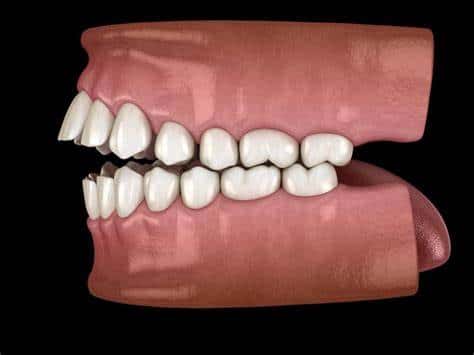Open bite is a dental condition that affects many individuals, leading to various challenges in both aesthetics and functionality. This malocclusion occurs when the upper and lower teeth do not come together properly, leaving a gap when the mouth is closed. Understanding the causes, effects, and treatment options for open bite can help in managing and mitigating the impact of this condition.
What is an Open Bite?
An open bite is characterized by a vertical space between the upper and lower teeth when the jaw is in a closed position. There are two primary types of open bite: anterior open bite, which affects the front teeth, and posterior open bite, where the molars and premolars do not touch. The severity of open bite can vary greatly — from a slight gap that’s barely noticeable to significant space that affects a person’s bite and overall dental health.
Causes of Open Bite
Several factors can contribute to the development of an open bite:
-
- Genetics: Inherited traits can influence jaw structure and tooth alignment, making some individuals more predisposed to developing an open bite.
- Genetics: Inherited traits can influence jaw structure and tooth alignment, making some individuals more predisposed to developing an open bite.
-
- Habits: Certain oral habits during childhood can contribute to an open bite. Thumb sucking, prolonged bottle feeding, and the use of pacifiers can change dental development and lead to malocclusion.
- Habits: Certain oral habits during childhood can contribute to an open bite. Thumb sucking, prolonged bottle feeding, and the use of pacifiers can change dental development and lead to malocclusion.
-
- Jaw Misalignment: Conditions such as temporomandibular joint (TMJ) disorder or congenital abnormalities can cause an imbalance in jaw positioning.
- Jaw Misalignment: Conditions such as temporomandibular joint (TMJ) disorder or congenital abnormalities can cause an imbalance in jaw positioning.
-
- Dental Issues: A lack of proper dental care can lead to misaligned teeth and gum diseases, further complicating the bite.
- Dental Issues: A lack of proper dental care can lead to misaligned teeth and gum diseases, further complicating the bite.
-
- Dental Treatments: In some cases, previous orthodontic treatments may inadvertently exacerbate or lead to open bite issues if not managed properly.

Effects of Open Bite
The implications of open bite extend beyond mere cosmetic concerns. They can have significant effects on the individual’s quality of life, including:
-
- Chewing and Eating Difficulties: An open bite can impede effective chewing, leading to digestive issues or dietary restrictions.
- Chewing and Eating Difficulties: An open bite can impede effective chewing, leading to digestive issues or dietary restrictions.
-
- Speech Problems: Those with an open bite may experience difficulty pronouncing certain words, leading to speech impediments that can affect communication.
- Speech Problems: Those with an open bite may experience difficulty pronouncing certain words, leading to speech impediments that can affect communication.
-
- Jaw and Facial Discomfort: The misalignment of teeth can lead to uneven wear on enamel, jaw pain, headaches, and increased stress on the temporomandibular joints.
- Jaw and Facial Discomfort: The misalignment of teeth can lead to uneven wear on enamel, jaw pain, headaches, and increased stress on the temporomandibular joints.
-
- Self-Esteem Issues: Aesthetic concerns related to open bite can impact an individual’s self-esteem and confidence, leading to psychological distress.
- Self-Esteem Issues: Aesthetic concerns related to open bite can impact an individual’s self-esteem and confidence, leading to psychological distress.
-
- Increased Risk of Dental Issues: Open bites can increase the likelihood of dental problems such as gum disease and tooth decay due to improper cleaning.
Treatment Options
Treating an open bite typically involves a multidisciplinary approach depending on the severity and underlying causes. Here are some common treatment options:
-
- Orthodontics: Braces or clear aligners are often the primary treatment for an open bite. Orthodontists can apply gradual pressure to reposition teeth and improve jaw alignment.
- Orthodontics: Braces or clear aligners are often the primary treatment for an open bite. Orthodontists can apply gradual pressure to reposition teeth and improve jaw alignment.
-
- Dental Appliances: Retainers and other oral devices can help correct habits like thumb sucking or provide necessary support to achieve proper alignment.
- Dental Appliances: Retainers and other oral devices can help correct habits like thumb sucking or provide necessary support to achieve proper alignment.
-
- Surgical Intervention: In moderate to severe cases, particularly those involving jaw misalignment, surgical options may be recommended to reposition the jaw for a better fit.
- Surgical Intervention: In moderate to severe cases, particularly those involving jaw misalignment, surgical options may be recommended to reposition the jaw for a better fit.
-
- Behavioral Strategies: Addressing any underlying habits that contribute to an open bite, such as thumb sucking, is crucial. Behavioral therapy or positive reinforcement strategies may be implemented to help eliminate these habits.
- Behavioral Strategies: Addressing any underlying habits that contribute to an open bite, such as thumb sucking, is crucial. Behavioral therapy or positive reinforcement strategies may be implemented to help eliminate these habits.
-
- Regular Dental Check-ups: Regular visits to the dentist for monitoring and maintenance can help catch potential issues early and provide necessary interventions.
Conclusion
Open bite is a complex issue that requires comprehensive understanding and treatment. By recognizing the causes, effects, and available treatment options, individuals affected by this condition can take proactive steps toward achieving a healthier, more functional bite. Collaborative care involving orthodontists, dentists, and, when necessary, oral surgeons can lead to improved outcomes and a better quality of life. If you suspect that you or your child may have an open bite, seek professional advice to explore the best treatment options available.